Honey Badger
Mellivora Capensis
Most fearless animal on Earth!
Advertisement
Honey Badger Scientific Classification
- Kingdom
- Animalia
- Phylum
- Chordata
- Class
- Mammalia
- Order
- Carnivora
- Family
- Mustelidae
- Genus
- Mellivora
- Scientific Name
- Mellivora Capensis
Read our Complete Guide to Classification of Animals.
Honey Badger Conservation Status
Honey Badger Facts
- Prey
- Bees, Insects, Small Animals, Bulbs, Roots, Bird Eggs
- Name Of Young
- Kit
- Fun Fact
- Most fearless animal on Earth!
- Estimated Population Size
- Unknown
- Biggest Threat
- Humans
- Most Distinctive Feature
- Large, sharp claws
- Other Name(s)
- Ratel
- Gestation Period
- 6 Months
- Habitat
- Dry Areas, Grasslands, Forests
- Predators
- Leopards, Spotted Hyenas, Pythons, Crocodiles
- Diet
- Omnivore
- Average Litter Size
- 2
- Lifestyle
- Diurnal
- Crepuscular
- or Nocturnal Depending on Region and Season
- Common Name
- Honey Badger
- Number Of Species
- 1
- Location
- Africa, Asia, Indian Subcontinent
- Slogan
- One of earth's bravest creatures!
- Group
- Mammal
Honey Badger Physical Characteristics
- Skin Type
- Hair
- Lifespan
- 7-8 years in the wild, 24 years in captivity
- Weight
- 11 to 35 pounds
- Height
- 9.1 to 11 inches
- Length
- 22 to 30 inches
- Age of Sexual Maturity
- 1 to 2 Years
- Age of Weaning
- 2 to 3 Months
View all of the Honey Badger images!
Honey badgers are the world’s most fearless animals.
Capybaras win the award for the world’s friendliest animal, but on the opposite end of the spectrum sits the honey badger, the planet’s gnarliest mammal! The “Guinness Book of World Records” lists the small, weasel-like species as the most fearless on Earth. And thanks to a 2011 viral YouTube video, they have earned the reputation for “not caring” — an apt description for animals that attack and steal at will!
Scientists haven’t studied the honey badger that much – maybe because of the animal’s bad reputation and inhospitable personality. Regardless, let’s dive into what we do know!
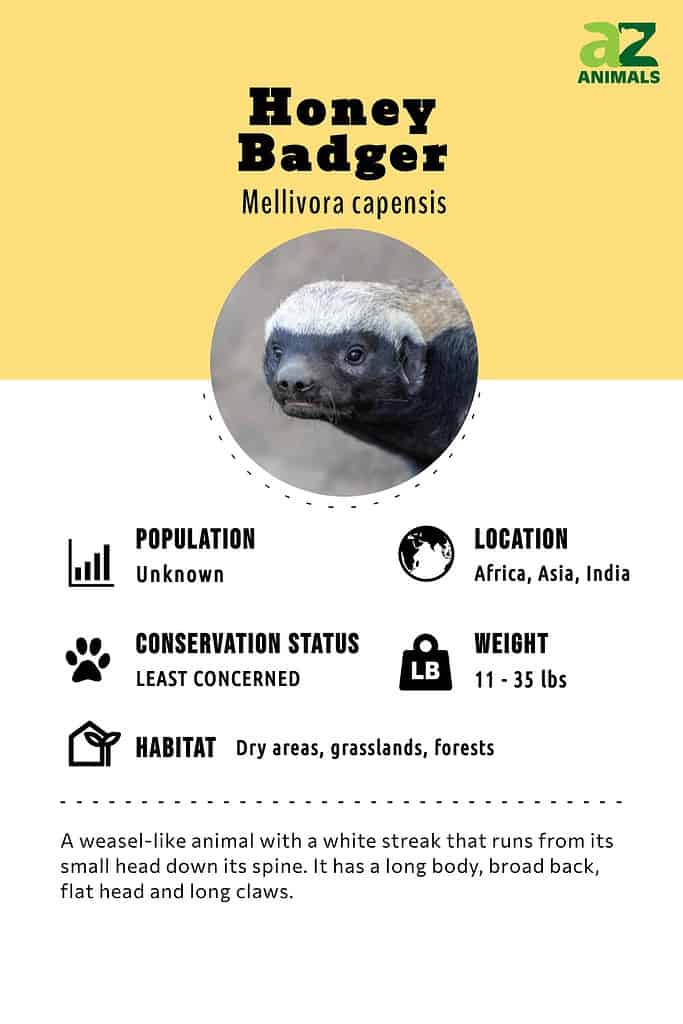
6 Phenomenal Honey Badger Facts
- Honey badgers are one of the few animals naturally immune to venomous snake bites. It’s believed they developed this over time by eating slightly venomous creatures first and working their way up.
- Their thick, loose skin can easily withstand shots from bows, arrows, and even machetes! The most effective way to kill honey badgers is a gunshot or skull-breaking blow to the back of the head.
- Honey badgers are the only species in the Mellivora genus and are often locally known as ‘ratels.’
- Using their sharp claws, ratels can dig a nearly 10-foot-long tunnel into hard earth within 10 minutes.
- “Honey Badger” has become a common nickname for athletes and politicians with ruthless reputations.
- In 2011, a video entitled “The Crazy Nastyass Honey Badger” went viral. It was a compilation of various honey badgers doing their ferocious thing, and the voice-over was a man saying, “honey badgers don’t care.” To date, people have viewed the video nearly 100 million times.
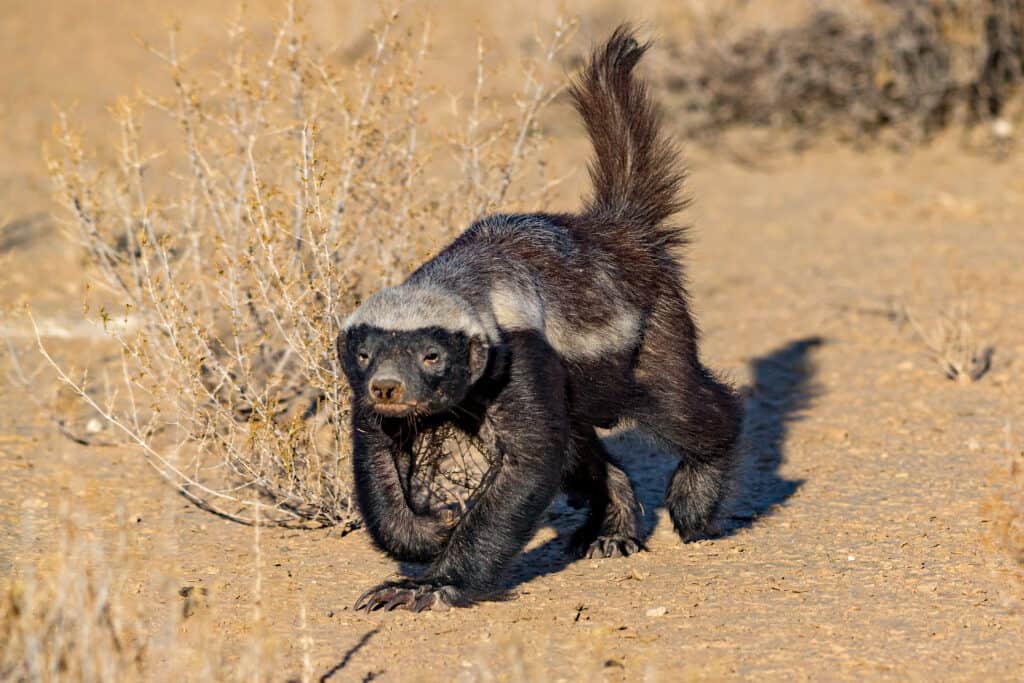
Honey badgers are also called “ratels” and are known to be one of the most fearless animals on the planet.
©Braam Collins/Shutterstock.com
Scientific Name
The scientific name for honey badger is Mellivora capensis. Mellivora comes from both ancient Greek and Latin. “Meli” is Greek for “honey,” and “varo” is a Latin verb meaning “to eat” or “to devour.” Capensis is a geographical reference to the Cape of Good Hope, where Johann Christian Daniel von Schreber first described the species. So, strung together, the scientific name for honey badgers translates to “honey eater of the cape.” Which is fitting, since these animals do like to eat honey.
In some parts of the world, the animals are also known as “ratels.”
Evolution
The evolution of the honey badger is murky, at best. Scientists believe that honey badgers and the American badger evolved from weasels before the “true” badgers of Eurasia ever appeared. There is one species of honey badger that lives all over Africa, the Middle East, and India.
Fossil records are scarce, but an obvious example of an early honey badger was found in Pakistan in the 1860s and is estimated to have lived during the Ice Age two million years ago. Mellivora sivalensis was found in only one location and hasn’t been well studied.
Mellivora benfieldi has been identified in fossils from Italy, South Africa, and Ethiopia. They lived during the Late Miocene, 5 to 6 million years ago. The fossils of the honey badgers have been found among the fossils of sabretooth cats.
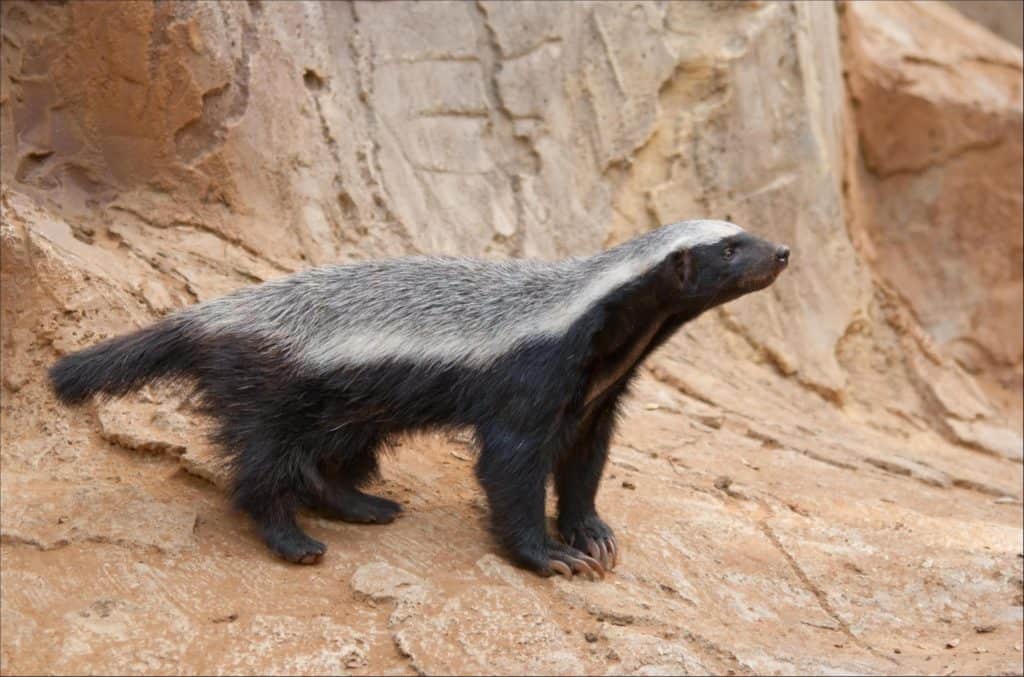
Honey badgers are related to weasels but look more like skunks with thick loose skin.
©Meoita/Shutterstock.com
Appearance
What do honey badgers look like? Well, anatomically speaking, they have more in common with weasels than other badgers. But in everyday terms, you could say that honey badgers resemble overgrown skunks.
Scientists currently recognize 12 honey badger subspecies with slight aesthetic differences. Generally speaking, all honey badgers have long bodies, broad backs, flat heads, short legs, small eyes, tiny ear ridges, stumpy tails, and short muzzles. What isn’t tiny are their claws, which are strong and long.
Honey badgers are animals that are also known for having steel-like skin. It’s thick and loose and can withstand arrow piercings and machete attacks. Plus, bee stings and porcupine pricks don’t affect them in the slightest.
Depending on the subspecies, honey badgers have all-black fur or black fur with a white streak that runs along their spine. In the winter, they carry long, dense fur coats, which are shed in the summer.
Size-wise, ratels are the largest land mustelids in Africa. Typically, measuring from the shoulder, they’re between 9.1 and 11 inches tall and 22 to 30 inches long. Males usually weigh about 20 to 35 pounds on average; while females tip the scales between 11 and 22 pounds – about the size of a small or medium dog.
But if you find yourself lost in the bush, know that honey badgers can grow to enormous sizes under ideal conditions. Good examples are the three 40-pound females that researchers found living in the Iraqi wild.
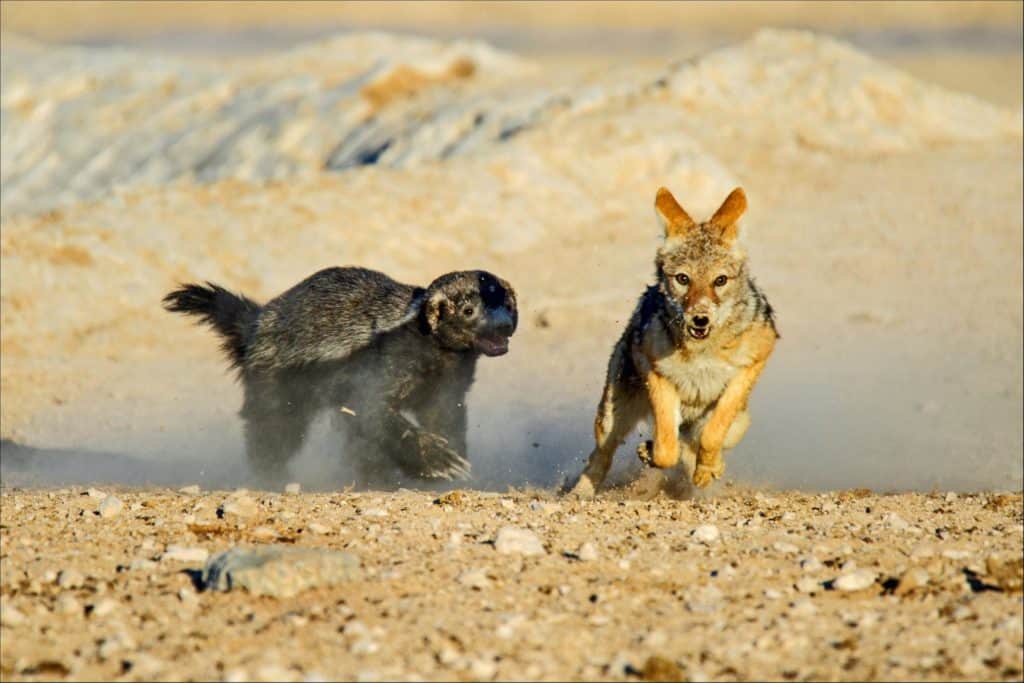
Honey badgers aren’t afraid to fight animals much larger than themselves.
©Dirk Theron/Shutterstock.com
Behavior
In terms of behavior, honey badgers are animals that are both notoriously cranky and aggressive. Ratels are both fearless and mean, and they’ll attack almost any animal, including humans, when there’s no escape. To boot, they purposely pick fights and rudely take over other animals‘ dens. Learn more about the toughest animals in the world here. For the most part, honey badgers stick to themselves, but mating pairs occasionally hang out together in the spring.
As Mother Nature’s backhoe, honey badgers are skilled diggers that can claw long tunnels and burrows in under 10 minutes. Other times, when they’re feeling lazy, ratels will commander the dens of aardvarks and warthogs.
Like skunks, honey badgers omit an atrocious odor to repel predators. Their scent also paralyzes bees, making it easier for honey badgers to raid hives for honey.
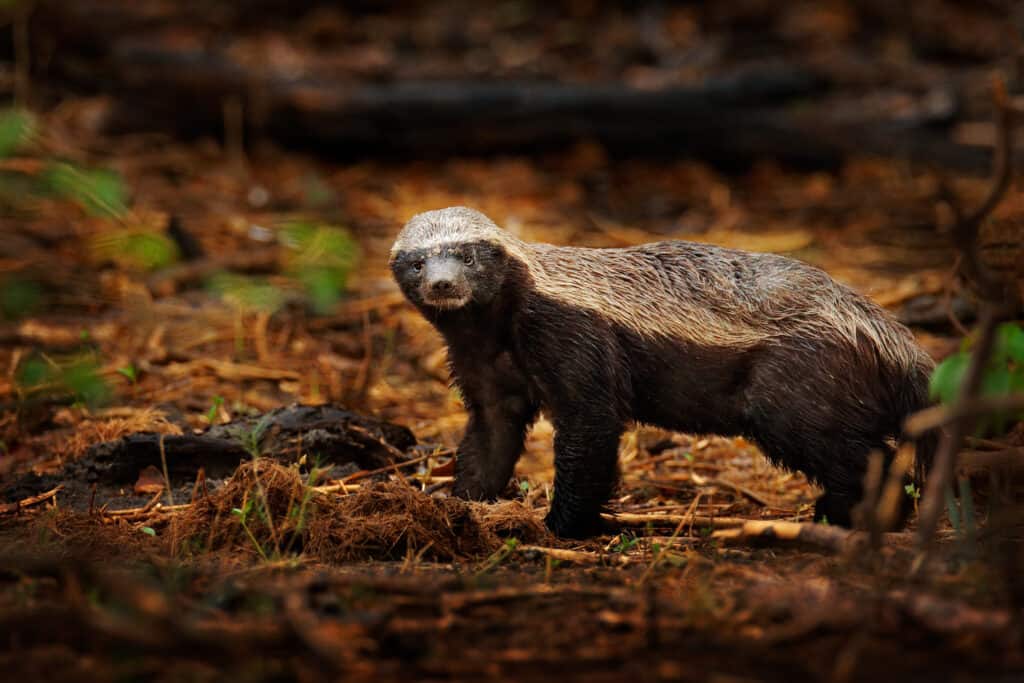
Honey badgers can thrive in arid grasslands or forest habitats.
©Ondrej Prosicky/Shutterstock.com
Habitat
Twelve subspecies of honey badgers are scattered across Africa and parts of the Middle East, Asia, and the Indian subcontinent. Populations of the species stick to dry areas, grasslands, and forests.
Subspecies
The 12 different species of honey badgers live in different areas, shown in the table below.
| Subspecies | Location |
|---|---|
| Cape Ratel | South and Southwestern Africa |
| Indian Ratel | Asia, Afghanistan, Iran, Pakistan, India |
| Nepalese Ratel | Nepal |
| White-Backed Ratel | West Africa, Southern Morocco, Congo, Gabon, Central African Republic |
| Black Ratel | Ghana, Congo |
| Lake Chad Ratel | Sudan, Somali-land |
| Speckled Ratel | Sierra Leone |
| Ethiopian Ratel | Ethiopia |
| Persian Ratel | Iran, Iraq |
| Kenyan Ratel | Kenya |
| Arabian Ratel | Southern Arabia |
| Turkmenian Ratel | Turkmenistan |
Diet
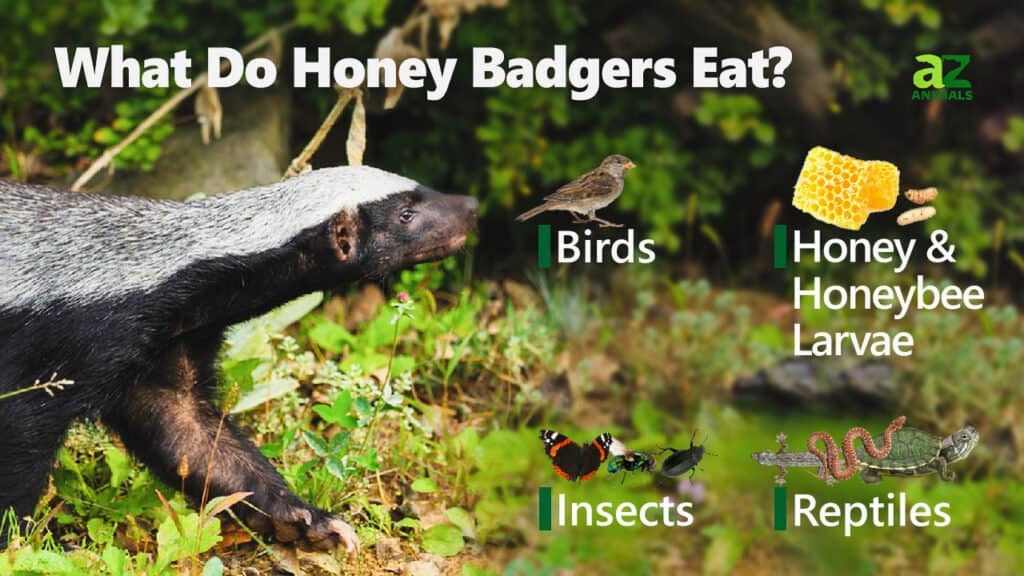
Ratels are omnivores with gigantic appetites, and when they kill, they eat the entire animal, including fur and feathers.
Honey badgers derive a chunk of their nutrients from digging up larvae and other insects, but they also feast on snakes, frogs, lizards, turtles, rodents, bird eggs, berries, bulbs, and roots. Honey badgers who call the Kalahari home also eat sheep and goats, and in India, ratels sometimes dig up human remains for meals.
They also eat a lot of poultry, and it’s nearly impossible for game farmers to guard against honey badgers because they dig tunnels to gain access to chicken coups. Plus, honey badgers can dismantle wood enclosures with little effort.
Evidenced by their name, honey badgers also love honey and regularly raid beehives to snatch their favorite snack.
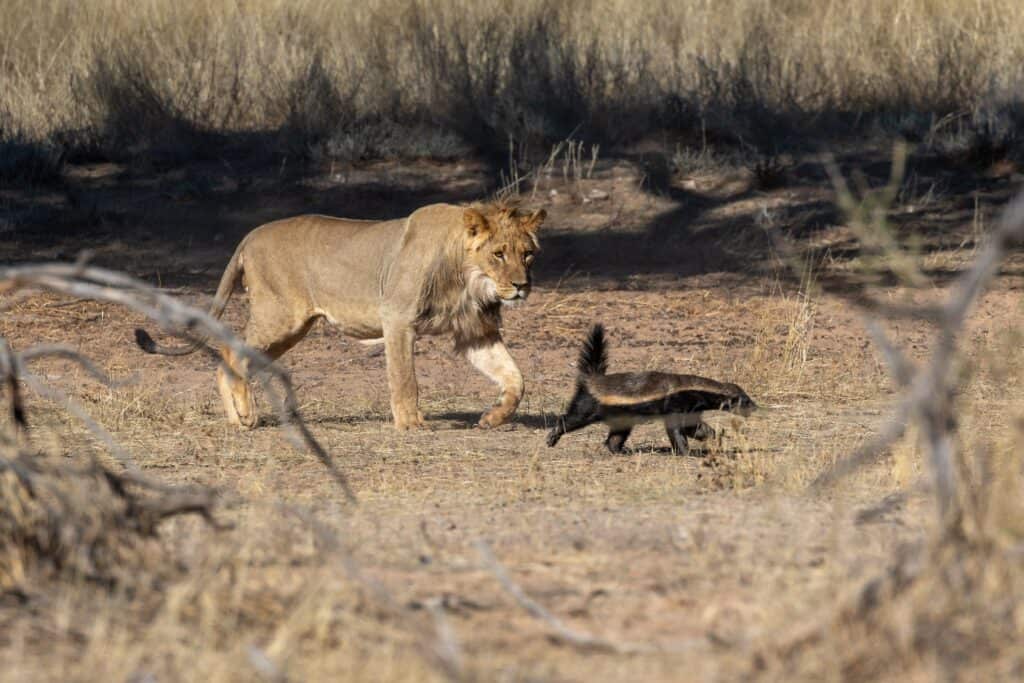
Lions occasionally kill honey badgers – but typically give them a wide berth.
©LouisLotterPhotography/Shutterstock.com
Predators and Threats
Humans aren’t the only species that honor honey badgers as formidable and ferocious foes. Even mighty lions — though they’ve been known to kill honey badgers on occasion — will typically grant the tenacious fighters a wide berth.
Not only is the species combative by nature, but their anatomical features serve as highly effective armor. They can squirm around in their thick, loose skin, making it harder for would-be predators to latch on. Plus, honey badgers are equipped with killer claws and teeth strong enough to slice through tortoise shells.
Despite their formidable defense mechanisms, honey badgers have a handful of natural predators, including African leopards, African rock pythons, Nile crocodiles, and spotted hyenas. Habitat encroachment is also a problem.
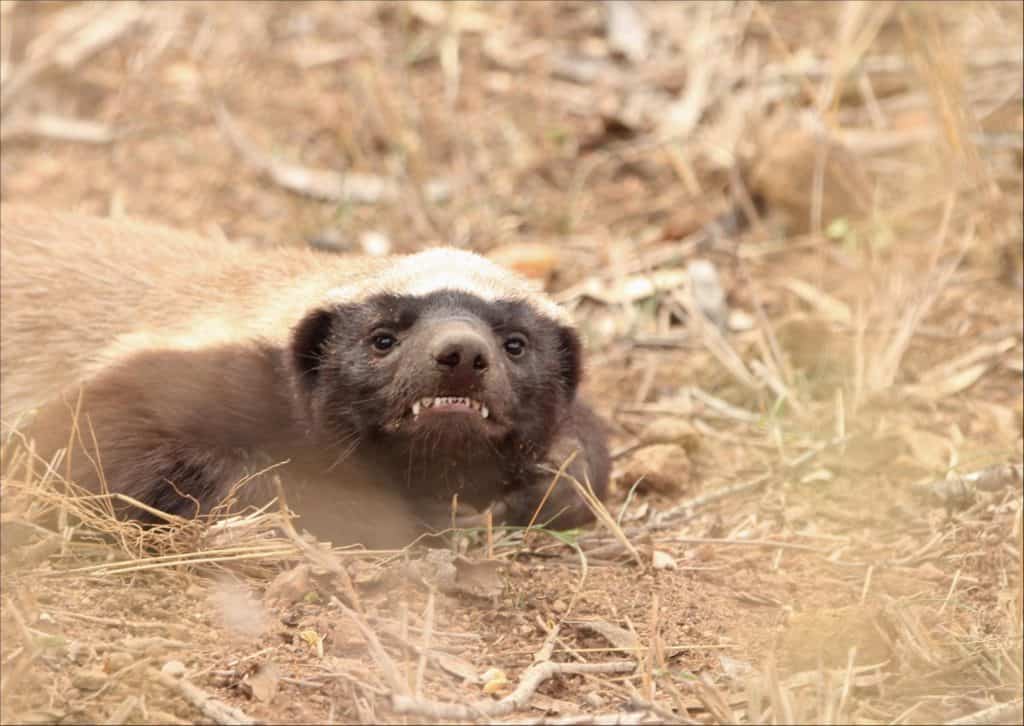
Baby honey badgers are called kits and live with their mothers for up to a year.
©Justin Tyler Barlow/Shutterstock.com
Reproduction, Babies, and Lifespan
Very little is known about honey badgers’ reproductive and parenting lives. The only reliable data is from a 42-month-long study conducted by the Kgalagadi Transfrontier National Park.
What do we know about honey badger reproduction? They mate throughout the year, with a spike in the spring, and gestation lasts about six months. Females have four teats to nurse newborns but only give birth to one or two kits — the term for badger cubs — at a time.
Babies are born blind, suckle for two to three months, and are dependent on their mothers for about a year. In the wild, honey badgers live for about seven to eight years, whereas individuals living in captivity live to the ripe old honey badger age of about 24.
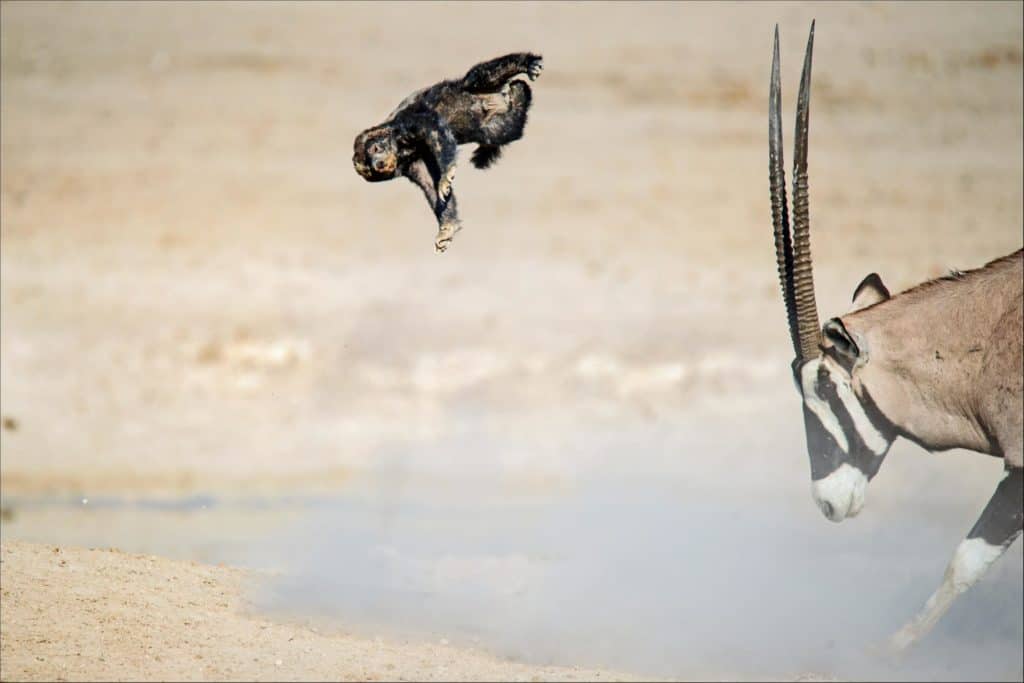
Honey badgers seem to be able to survive almost anything and are not in danger of extinction.
©Dirk Theron/Shutterstock.com
Population
According to the International Union for the Conservation of Nature, honey badgers are a least concern species and not in danger of imminent extinction. But that doesn’t mean honey badgers are without threats.
Human population growth causes more wildlife encroachment. In the days of old, people and honey badgers rarely came into contact. But these days, honey badgers often find themselves face-to-face with armed farmers committed to protecting their livestock. As a result, honey badger population numbers are declining.
Currently, there isn’t a worldwide estimate for the honey badger population, but they’re disappearing from places where they were once plentiful.
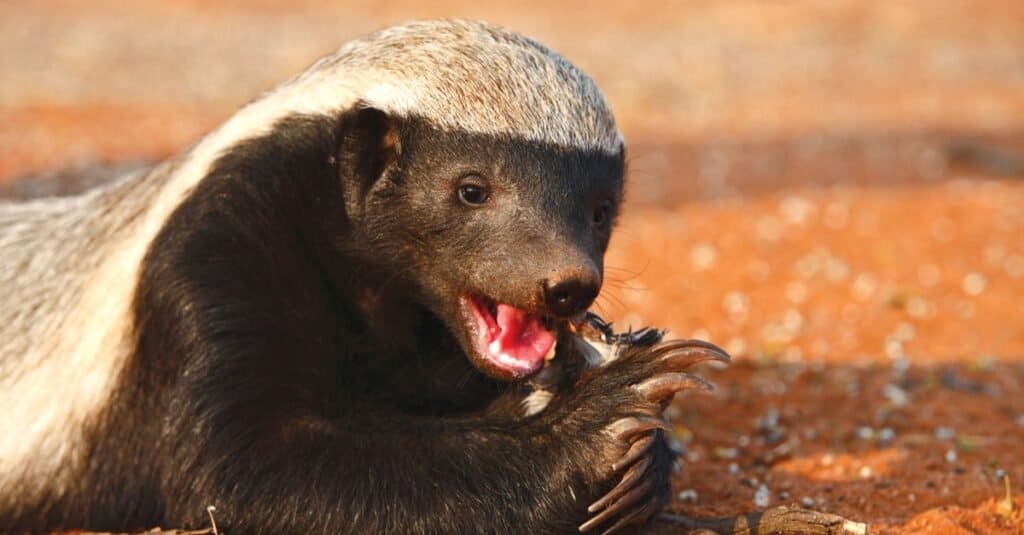
Up to 25 percent of the honey badger’s omnivorous diet consists of venomous snakes.
©Erwin Niemand/Shutterstock.com
Honey Badger FAQs
What is a honey badger?
A honey badger is a weasel-like, hyper-aggressive, four-legged animal that lives in parts of Africa, the Middle East, Asia, and India.
Are honey badgers carnivores, herbivores, or omnivores?
Honey badgers are omnivores, meaning they eat flesh and plants. Much of their diet consists of insects, but they will also eat snakes, turtles, berries, and, of course, honey.
Can a honey badger kill a human?
The jury is still out as to whether or not honey badgers kill humans. There are stories from the early 20th century of man-eating ratels, but historians and scientists think they’re probably folklore. However, Indian honey badgers reportedly attack young children, and individuals of the subspecies are known to dig up human remains for dinner.
In 2007, a conspiracy theory circulated about “man-eating” honey badgers in Iraq. But according to area vets and conservationists, honey badgers have always lived in the country’s rural areas, but a marshland flooding north of Basra that year pushed the animals towards the city.
How aggressive is a honey badger?
Honey badgers are one of the most aggressive species on Earth! The “Guinness Book of World Records” lists them as the world’s most fearless animals.
Why are honey badgers so fearless?
Honey badgers are so bold because they have built-in armor. Due to their protective skin, hardly anything can penetrate them, including other animals’ teeth, machetes, and arrows! Plus, they’re naturally aggressive, have strong jaws, and were endowed with teeth that can cut through just about anything.
How dangerous is a honey badger?
Honey badgers are dangerous! They never back down, have lethal teeth, and attack any moving thing if they feel threatened.
View all 104 animals that start with HHoney Badger FAQs (Frequently Asked Questions)
Could a Honey Badger battle a Komodo Dragon?
One question that’s often asked about honey badgers is whether they could battle much larger creatures. If a honey badger were to battle a Komodo dragon, it’s likely the Komodo dragon would simply be too large for the honey badger. With the two living on different continents, this battle has never happened in nature, however.
Are Honey Badgers herbivores, carnivores, or omnivores?
Honey Badgers are Omnivores, meaning they eat both plants and other animals.
What Kingdom do Honey Badgers belong to?
Honey Badgers belong to the Kingdom Animalia.
What phylum do Honey Badgers belong to?
Honey Badgers belong to the phylum Chordata.
What class do Honey Badgers belong to?
Honey Badgers belong to the class Mammalia.
What family do Honey Badgers belong to?
Honey Badgers belong to the family Mustelidae.
What order do Honey Badgers belong to?
Honey Badgers belong to the order Carnivora.
What type of covering do Honey Badgers have?
Honey Badgers are covered in Hair.
Where do Honey Badgers live?
Honey Badgers live in Africa, Asia, and the Indian subcontinent.
In what type of habitat do Honey Badgers live?
Honey Badgers live in dry areas, grasslands, and forests.
What are some predators of Honey Badgers?
Predators of Honey Badgers include leopards, spotted hyenas, pythons, and crocodiles.
What is the average litter size for a Honey Badger?
The average litter size for a Honey Badger is 2.
What is an interesting fact about Honey Badgers?
Honey Badgers are one of earth’s bravest creatures!
What is the scientific name for the Honey Badger?
The scientific name for the Honey Badger is Mellivora Capensis.
What is the lifespan of a Honey Badger?
Honey Badgers can live for 7 to 8 years in the wild and 24 years in captivity.
How many species of Honey Badger are there?
There is 1 species of Honey Badger.
What is the biggest threat to the Honey Badger?
The biggest threat to Honey Badgers is humans.
What is another name for the Honey Badger?
The Honey Badger is also called the ratel.
How many Honey Badgers are left in the world?
The population size of the Honey Badger is unknown.
Who would win a fight between a snake and a honey badger?
Honey badgers are going to kill a snake in a fight in just about every case. They live in Africa where they face some of the deadliest snakes in the world. Rather than avoiding them, honey badgers regularly eat snakes and go out of their way to kill them and eat them.
Do Honey Badgers Make Good Pets?
Since they are illegal to own in most world areas, honey badgers do not make good pets.
Who would win a fight between a honey badger and a black mamba?
A honey badger would beat a black mamba in a fight. Honey badgers are agile and capable of avoiding the black mamba’s attacks. When the fight starts, both animals will look to land killing blows. They’re highly aggressive.
What's the difference between a honey badger and a mongoose?
Honey badgers are much larger than mongooses are, and mongooses are more social than the aggressive honey badger.
Who would win in a fight between a honey badger and a king cobra?
The honey badger would kill the king cobra in a fight.
Thank you for reading! Have some feedback for us? Contact the AZ Animals editorial team.


















